Mental Health in Australian Children: A Healthcare Essay Analysis
VerifiedAdded on 2022/12/26
|11
|3096
|34
Essay
AI Summary
This essay delves into the prevalence and types of mental health issues affecting children and adolescents in Australia, drawing on statistical data from various sources. It explores the causes of these disorders, including family dynamics, stress, and societal pressures, with a particular focus on the role of parents in both the development and prevention of mental health problems. The essay discusses the effectiveness of current mental health services in Australia, highlighting the importance of early intervention and the need for increased awareness and support. It emphasizes the crucial role of parents and family members in identifying early signs of mental health issues and seeking professional help, advocating for a more comprehensive approach to address the mental health needs of young Australians. The essay concludes by underscoring the significance of a proactive and integrated approach to mental healthcare for children and adolescents, involving families, healthcare professionals, and government initiatives.

Running Head: Healthcare
Healthcare
Essay
System04104
4/30/2019
Healthcare
Essay
System04104
4/30/2019
Paraphrase This Document
Need a fresh take? Get an instant paraphrase of this document with our AI Paraphraser
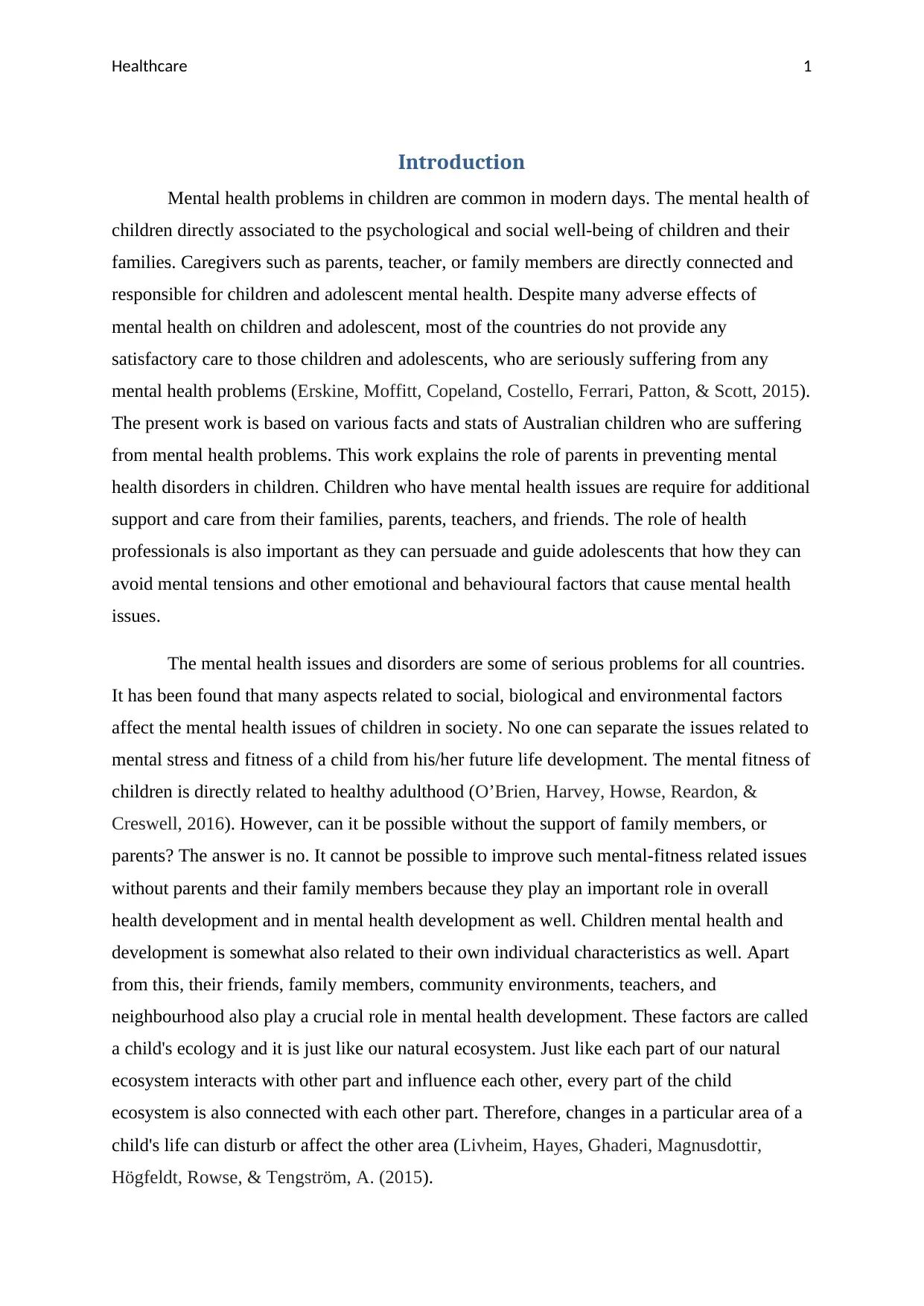
Healthcare 1
Introduction
Mental health problems in children are common in modern days. The mental health of
children directly associated to the psychological and social well-being of children and their
families. Caregivers such as parents, teacher, or family members are directly connected and
responsible for children and adolescent mental health. Despite many adverse effects of
mental health on children and adolescent, most of the countries do not provide any
satisfactory care to those children and adolescents, who are seriously suffering from any
mental health problems (Erskine, Moffitt, Copeland, Costello, Ferrari, Patton, & Scott, 2015).
The present work is based on various facts and stats of Australian children who are suffering
from mental health problems. This work explains the role of parents in preventing mental
health disorders in children. Children who have mental health issues are require for additional
support and care from their families, parents, teachers, and friends. The role of health
professionals is also important as they can persuade and guide adolescents that how they can
avoid mental tensions and other emotional and behavioural factors that cause mental health
issues.
The mental health issues and disorders are some of serious problems for all countries.
It has been found that many aspects related to social, biological and environmental factors
affect the mental health issues of children in society. No one can separate the issues related to
mental stress and fitness of a child from his/her future life development. The mental fitness of
children is directly related to healthy adulthood (O’Brien, Harvey, Howse, Reardon, &
Creswell, 2016). However, can it be possible without the support of family members, or
parents? The answer is no. It cannot be possible to improve such mental-fitness related issues
without parents and their family members because they play an important role in overall
health development and in mental health development as well. Children mental health and
development is somewhat also related to their own individual characteristics as well. Apart
from this, their friends, family members, community environments, teachers, and
neighbourhood also play a crucial role in mental health development. These factors are called
a child's ecology and it is just like our natural ecosystem. Just like each part of our natural
ecosystem interacts with other part and influence each other, every part of the child
ecosystem is also connected with each other part. Therefore, changes in a particular area of a
child's life can disturb or affect the other area (Livheim, Hayes, Ghaderi, Magnusdottir,
Högfeldt, Rowse, & Tengström, A. (2015).
Introduction
Mental health problems in children are common in modern days. The mental health of
children directly associated to the psychological and social well-being of children and their
families. Caregivers such as parents, teacher, or family members are directly connected and
responsible for children and adolescent mental health. Despite many adverse effects of
mental health on children and adolescent, most of the countries do not provide any
satisfactory care to those children and adolescents, who are seriously suffering from any
mental health problems (Erskine, Moffitt, Copeland, Costello, Ferrari, Patton, & Scott, 2015).
The present work is based on various facts and stats of Australian children who are suffering
from mental health problems. This work explains the role of parents in preventing mental
health disorders in children. Children who have mental health issues are require for additional
support and care from their families, parents, teachers, and friends. The role of health
professionals is also important as they can persuade and guide adolescents that how they can
avoid mental tensions and other emotional and behavioural factors that cause mental health
issues.
The mental health issues and disorders are some of serious problems for all countries.
It has been found that many aspects related to social, biological and environmental factors
affect the mental health issues of children in society. No one can separate the issues related to
mental stress and fitness of a child from his/her future life development. The mental fitness of
children is directly related to healthy adulthood (O’Brien, Harvey, Howse, Reardon, &
Creswell, 2016). However, can it be possible without the support of family members, or
parents? The answer is no. It cannot be possible to improve such mental-fitness related issues
without parents and their family members because they play an important role in overall
health development and in mental health development as well. Children mental health and
development is somewhat also related to their own individual characteristics as well. Apart
from this, their friends, family members, community environments, teachers, and
neighbourhood also play a crucial role in mental health development. These factors are called
a child's ecology and it is just like our natural ecosystem. Just like each part of our natural
ecosystem interacts with other part and influence each other, every part of the child
ecosystem is also connected with each other part. Therefore, changes in a particular area of a
child's life can disturb or affect the other area (Livheim, Hayes, Ghaderi, Magnusdottir,
Högfeldt, Rowse, & Tengström, A. (2015).
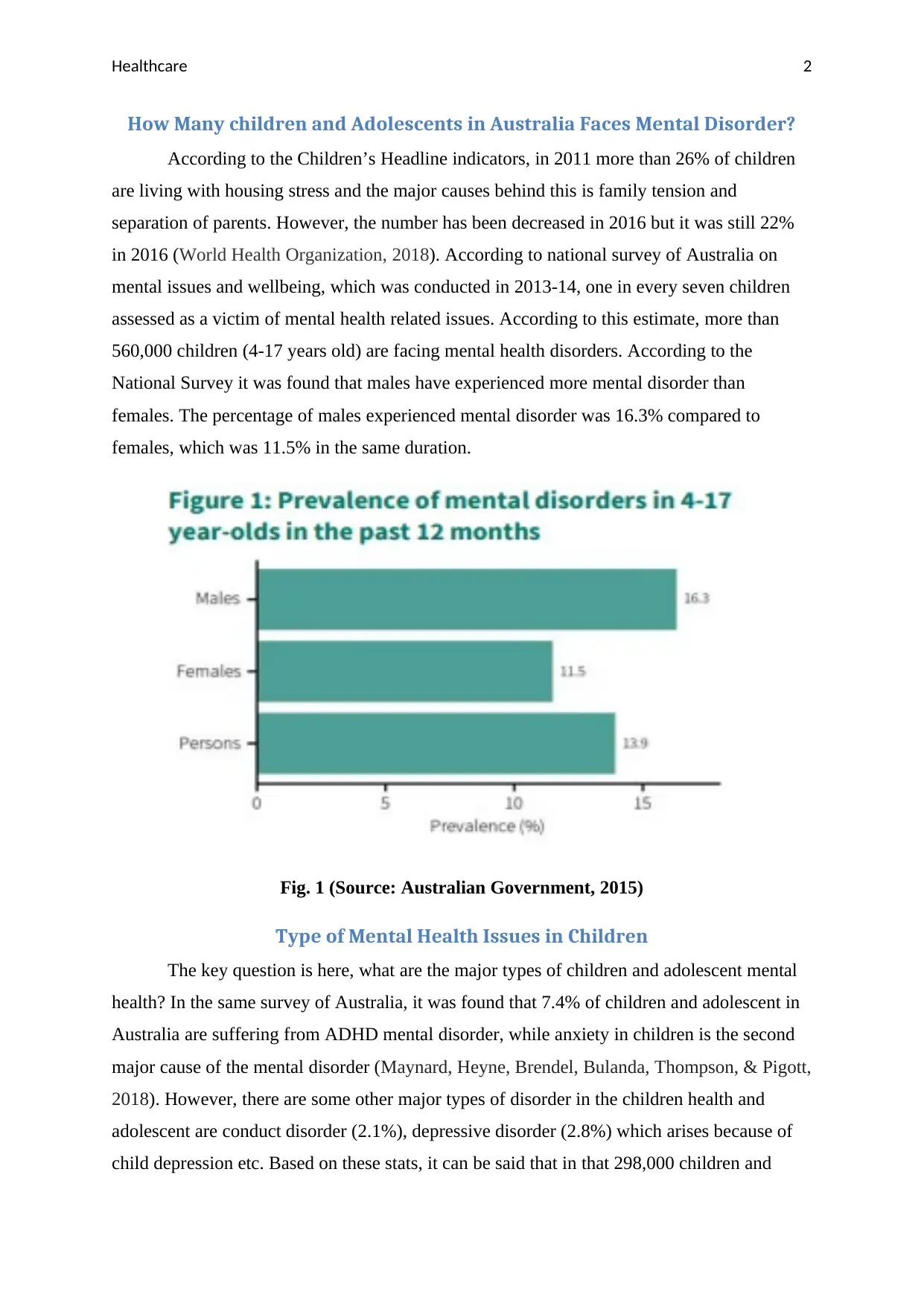
Healthcare 2
How Many children and Adolescents in Australia Faces Mental Disorder?
According to the Children’s Headline indicators, in 2011 more than 26% of children
are living with housing stress and the major causes behind this is family tension and
separation of parents. However, the number has been decreased in 2016 but it was still 22%
in 2016 (World Health Organization, 2018). According to national survey of Australia on
mental issues and wellbeing, which was conducted in 2013-14, one in every seven children
assessed as a victim of mental health related issues. According to this estimate, more than
560,000 children (4-17 years old) are facing mental health disorders. According to the
National Survey it was found that males have experienced more mental disorder than
females. The percentage of males experienced mental disorder was 16.3% compared to
females, which was 11.5% in the same duration.
Fig. 1 (Source: Australian Government, 2015)
Type of Mental Health Issues in Children
The key question is here, what are the major types of children and adolescent mental
health? In the same survey of Australia, it was found that 7.4% of children and adolescent in
Australia are suffering from ADHD mental disorder, while anxiety in children is the second
major cause of the mental disorder (Maynard, Heyne, Brendel, Bulanda, Thompson, & Pigott,
2018). However, there are some other major types of disorder in the children health and
adolescent are conduct disorder (2.1%), depressive disorder (2.8%) which arises because of
child depression etc. Based on these stats, it can be said that in that 298,000 children and
How Many children and Adolescents in Australia Faces Mental Disorder?
According to the Children’s Headline indicators, in 2011 more than 26% of children
are living with housing stress and the major causes behind this is family tension and
separation of parents. However, the number has been decreased in 2016 but it was still 22%
in 2016 (World Health Organization, 2018). According to national survey of Australia on
mental issues and wellbeing, which was conducted in 2013-14, one in every seven children
assessed as a victim of mental health related issues. According to this estimate, more than
560,000 children (4-17 years old) are facing mental health disorders. According to the
National Survey it was found that males have experienced more mental disorder than
females. The percentage of males experienced mental disorder was 16.3% compared to
females, which was 11.5% in the same duration.
Fig. 1 (Source: Australian Government, 2015)
Type of Mental Health Issues in Children
The key question is here, what are the major types of children and adolescent mental
health? In the same survey of Australia, it was found that 7.4% of children and adolescent in
Australia are suffering from ADHD mental disorder, while anxiety in children is the second
major cause of the mental disorder (Maynard, Heyne, Brendel, Bulanda, Thompson, & Pigott,
2018). However, there are some other major types of disorder in the children health and
adolescent are conduct disorder (2.1%), depressive disorder (2.8%) which arises because of
child depression etc. Based on these stats, it can be said that in that 298,000 children and
⊘ This is a preview!⊘
Do you want full access?
Subscribe today to unlock all pages.

Trusted by 1+ million students worldwide
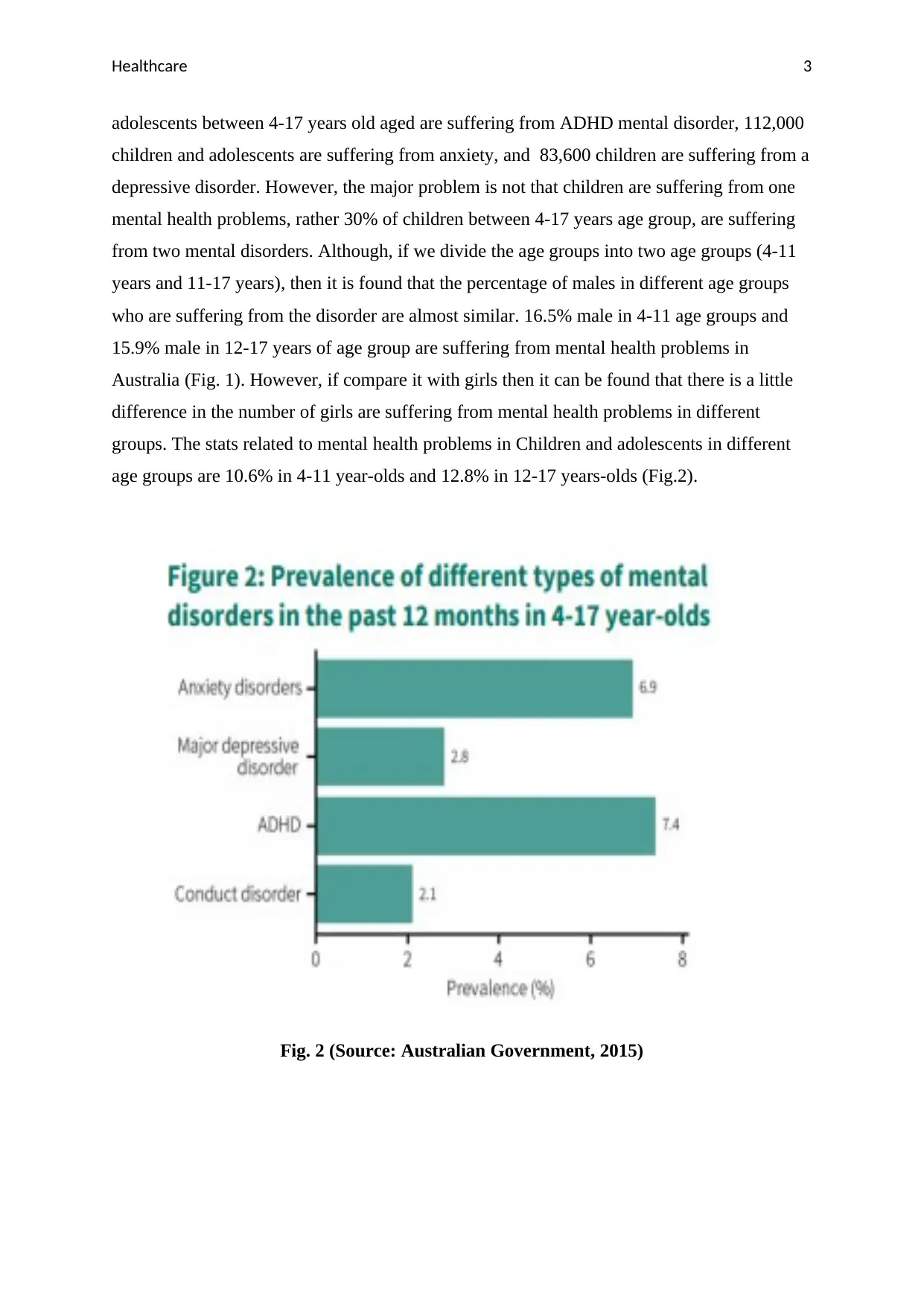
Healthcare 3
adolescents between 4-17 years old aged are suffering from ADHD mental disorder, 112,000
children and adolescents are suffering from anxiety, and 83,600 children are suffering from a
depressive disorder. However, the major problem is not that children are suffering from one
mental health problems, rather 30% of children between 4-17 years age group, are suffering
from two mental disorders. Although, if we divide the age groups into two age groups (4-11
years and 11-17 years), then it is found that the percentage of males in different age groups
who are suffering from the disorder are almost similar. 16.5% male in 4-11 age groups and
15.9% male in 12-17 years of age group are suffering from mental health problems in
Australia (Fig. 1). However, if compare it with girls then it can be found that there is a little
difference in the number of girls are suffering from mental health problems in different
groups. The stats related to mental health problems in Children and adolescents in different
age groups are 10.6% in 4-11 year-olds and 12.8% in 12-17 years-olds (Fig.2).
Fig. 2 (Source: Australian Government, 2015)
adolescents between 4-17 years old aged are suffering from ADHD mental disorder, 112,000
children and adolescents are suffering from anxiety, and 83,600 children are suffering from a
depressive disorder. However, the major problem is not that children are suffering from one
mental health problems, rather 30% of children between 4-17 years age group, are suffering
from two mental disorders. Although, if we divide the age groups into two age groups (4-11
years and 11-17 years), then it is found that the percentage of males in different age groups
who are suffering from the disorder are almost similar. 16.5% male in 4-11 age groups and
15.9% male in 12-17 years of age group are suffering from mental health problems in
Australia (Fig. 1). However, if compare it with girls then it can be found that there is a little
difference in the number of girls are suffering from mental health problems in different
groups. The stats related to mental health problems in Children and adolescents in different
age groups are 10.6% in 4-11 year-olds and 12.8% in 12-17 years-olds (Fig.2).
Fig. 2 (Source: Australian Government, 2015)
Paraphrase This Document
Need a fresh take? Get an instant paraphrase of this document with our AI Paraphraser
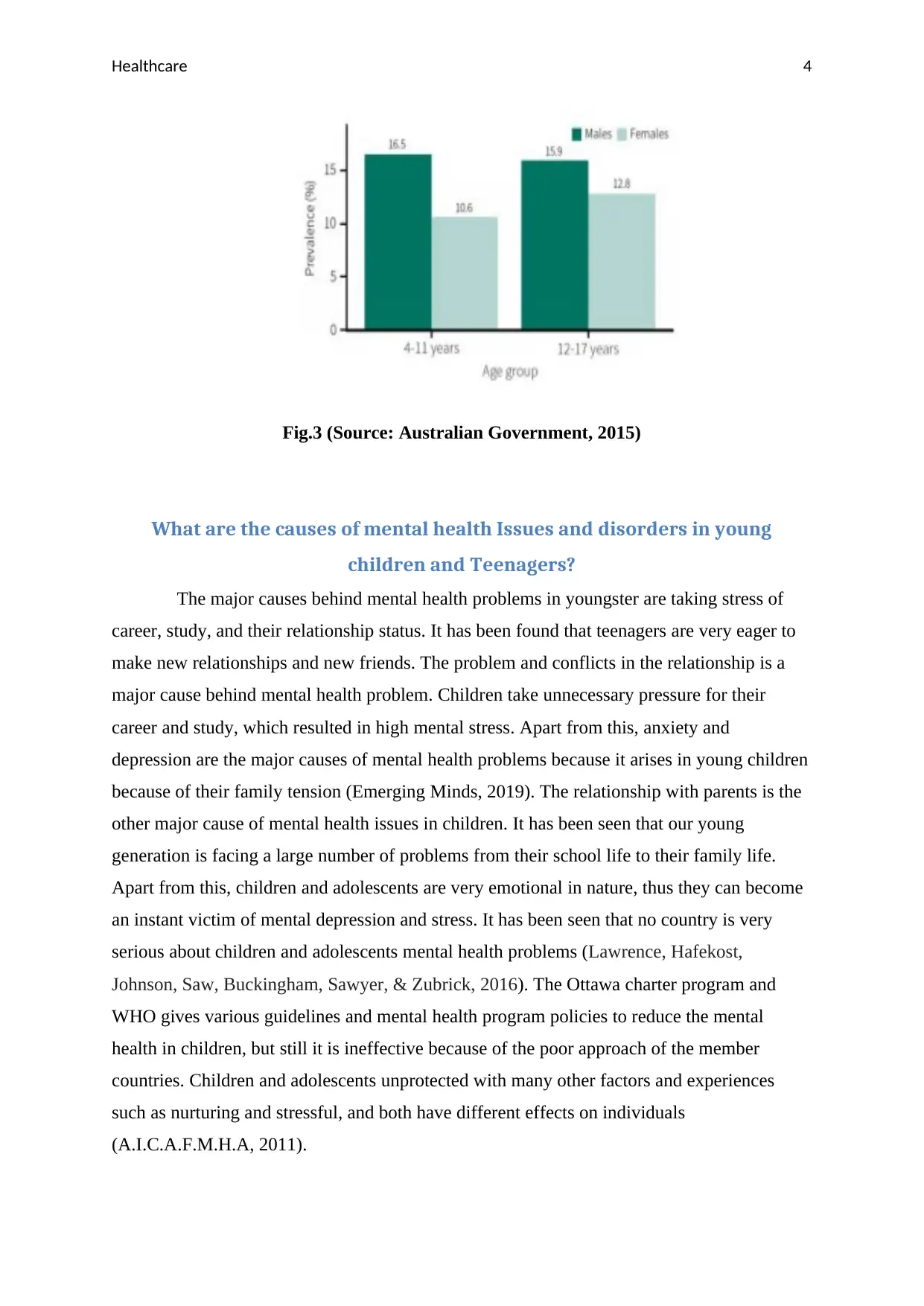
Healthcare 4
Fig.3 (Source: Australian Government, 2015)
What are the causes of mental health Issues and disorders in young
children and Teenagers?
The major causes behind mental health problems in youngster are taking stress of
career, study, and their relationship status. It has been found that teenagers are very eager to
make new relationships and new friends. The problem and conflicts in the relationship is a
major cause behind mental health problem. Children take unnecessary pressure for their
career and study, which resulted in high mental stress. Apart from this, anxiety and
depression are the major causes of mental health problems because it arises in young children
because of their family tension (Emerging Minds, 2019). The relationship with parents is the
other major cause of mental health issues in children. It has been seen that our young
generation is facing a large number of problems from their school life to their family life.
Apart from this, children and adolescents are very emotional in nature, thus they can become
an instant victim of mental depression and stress. It has been seen that no country is very
serious about children and adolescents mental health problems (Lawrence, Hafekost,
Johnson, Saw, Buckingham, Sawyer, & Zubrick, 2016). The Ottawa charter program and
WHO gives various guidelines and mental health program policies to reduce the mental
health in children, but still it is ineffective because of the poor approach of the member
countries. Children and adolescents unprotected with many other factors and experiences
such as nurturing and stressful, and both have different effects on individuals
(A.I.C.A.F.M.H.A, 2011).
Fig.3 (Source: Australian Government, 2015)
What are the causes of mental health Issues and disorders in young
children and Teenagers?
The major causes behind mental health problems in youngster are taking stress of
career, study, and their relationship status. It has been found that teenagers are very eager to
make new relationships and new friends. The problem and conflicts in the relationship is a
major cause behind mental health problem. Children take unnecessary pressure for their
career and study, which resulted in high mental stress. Apart from this, anxiety and
depression are the major causes of mental health problems because it arises in young children
because of their family tension (Emerging Minds, 2019). The relationship with parents is the
other major cause of mental health issues in children. It has been seen that our young
generation is facing a large number of problems from their school life to their family life.
Apart from this, children and adolescents are very emotional in nature, thus they can become
an instant victim of mental depression and stress. It has been seen that no country is very
serious about children and adolescents mental health problems (Lawrence, Hafekost,
Johnson, Saw, Buckingham, Sawyer, & Zubrick, 2016). The Ottawa charter program and
WHO gives various guidelines and mental health program policies to reduce the mental
health in children, but still it is ineffective because of the poor approach of the member
countries. Children and adolescents unprotected with many other factors and experiences
such as nurturing and stressful, and both have different effects on individuals
(A.I.C.A.F.M.H.A, 2011).
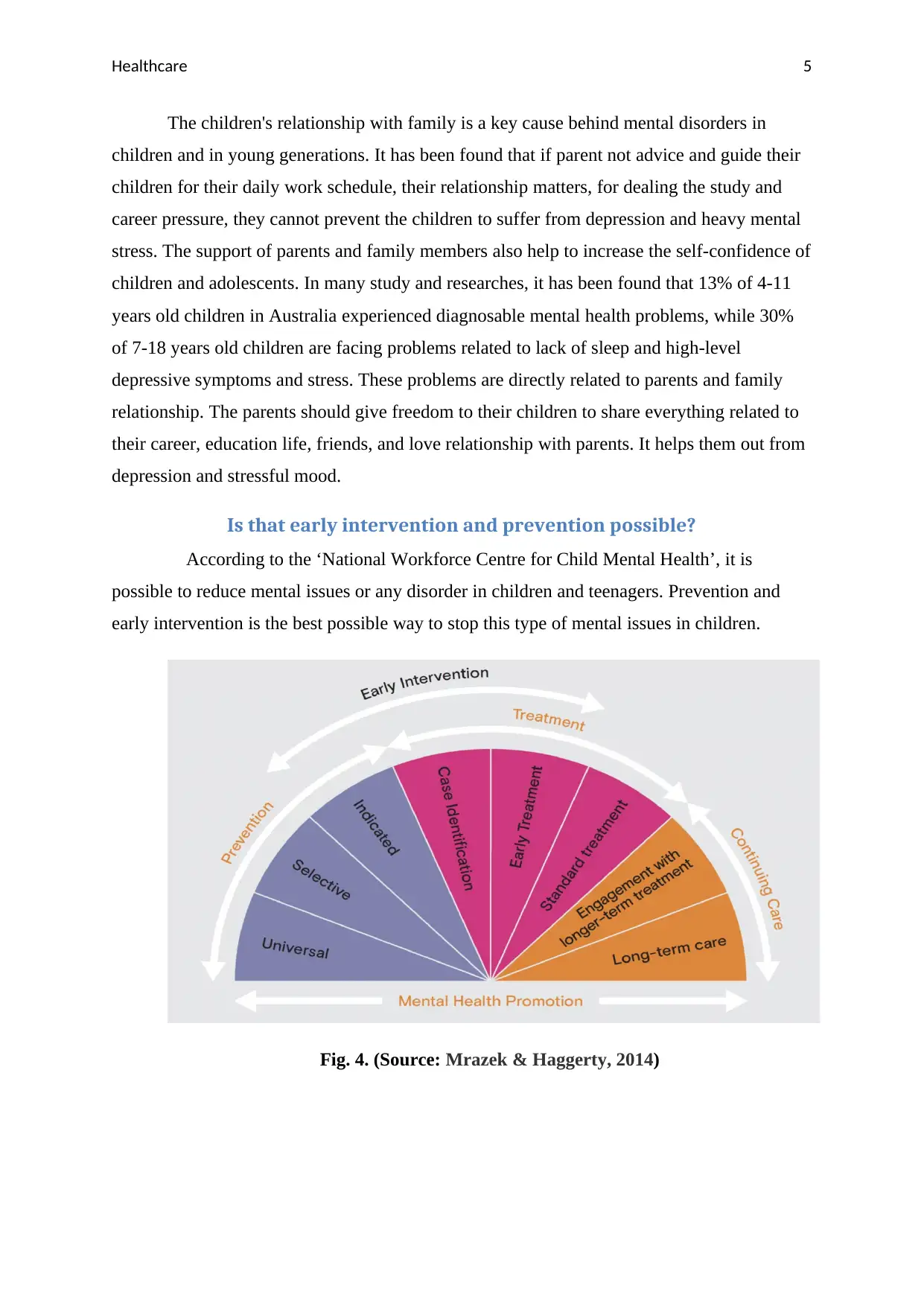
Healthcare 5
The children's relationship with family is a key cause behind mental disorders in
children and in young generations. It has been found that if parent not advice and guide their
children for their daily work schedule, their relationship matters, for dealing the study and
career pressure, they cannot prevent the children to suffer from depression and heavy mental
stress. The support of parents and family members also help to increase the self-confidence of
children and adolescents. In many study and researches, it has been found that 13% of 4-11
years old children in Australia experienced diagnosable mental health problems, while 30%
of 7-18 years old children are facing problems related to lack of sleep and high-level
depressive symptoms and stress. These problems are directly related to parents and family
relationship. The parents should give freedom to their children to share everything related to
their career, education life, friends, and love relationship with parents. It helps them out from
depression and stressful mood.
Is that early intervention and prevention possible?
According to the ‘National Workforce Centre for Child Mental Health’, it is
possible to reduce mental issues or any disorder in children and teenagers. Prevention and
early intervention is the best possible way to stop this type of mental issues in children.
Fig. 4. (Source: Mrazek & Haggerty, 2014)
The children's relationship with family is a key cause behind mental disorders in
children and in young generations. It has been found that if parent not advice and guide their
children for their daily work schedule, their relationship matters, for dealing the study and
career pressure, they cannot prevent the children to suffer from depression and heavy mental
stress. The support of parents and family members also help to increase the self-confidence of
children and adolescents. In many study and researches, it has been found that 13% of 4-11
years old children in Australia experienced diagnosable mental health problems, while 30%
of 7-18 years old children are facing problems related to lack of sleep and high-level
depressive symptoms and stress. These problems are directly related to parents and family
relationship. The parents should give freedom to their children to share everything related to
their career, education life, friends, and love relationship with parents. It helps them out from
depression and stressful mood.
Is that early intervention and prevention possible?
According to the ‘National Workforce Centre for Child Mental Health’, it is
possible to reduce mental issues or any disorder in children and teenagers. Prevention and
early intervention is the best possible way to stop this type of mental issues in children.
Fig. 4. (Source: Mrazek & Haggerty, 2014)
⊘ This is a preview!⊘
Do you want full access?
Subscribe today to unlock all pages.

Trusted by 1+ million students worldwide
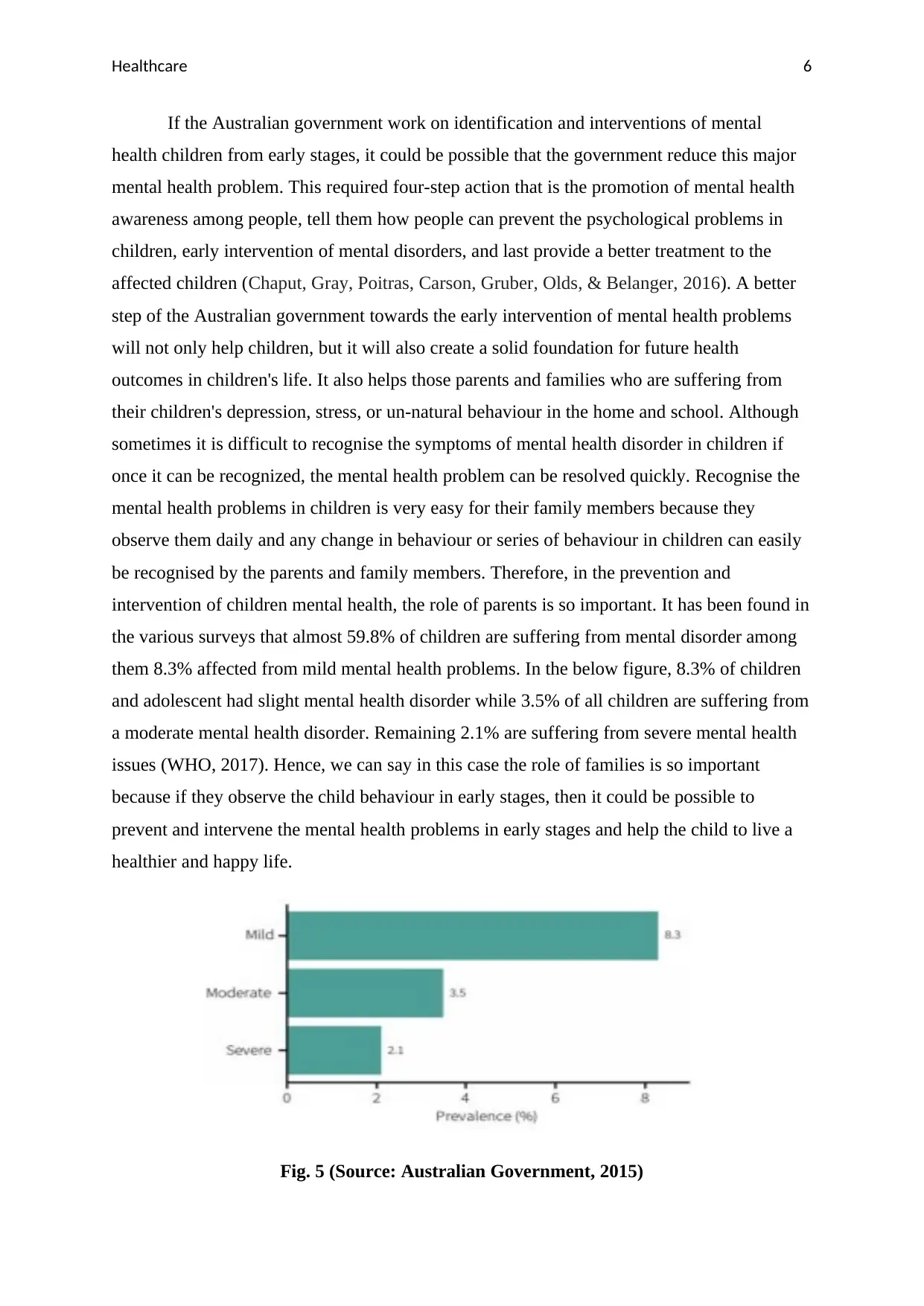
Healthcare 6
If the Australian government work on identification and interventions of mental
health children from early stages, it could be possible that the government reduce this major
mental health problem. This required four-step action that is the promotion of mental health
awareness among people, tell them how people can prevent the psychological problems in
children, early intervention of mental disorders, and last provide a better treatment to the
affected children (Chaput, Gray, Poitras, Carson, Gruber, Olds, & Belanger, 2016). A better
step of the Australian government towards the early intervention of mental health problems
will not only help children, but it will also create a solid foundation for future health
outcomes in children's life. It also helps those parents and families who are suffering from
their children's depression, stress, or un-natural behaviour in the home and school. Although
sometimes it is difficult to recognise the symptoms of mental health disorder in children if
once it can be recognized, the mental health problem can be resolved quickly. Recognise the
mental health problems in children is very easy for their family members because they
observe them daily and any change in behaviour or series of behaviour in children can easily
be recognised by the parents and family members. Therefore, in the prevention and
intervention of children mental health, the role of parents is so important. It has been found in
the various surveys that almost 59.8% of children are suffering from mental disorder among
them 8.3% affected from mild mental health problems. In the below figure, 8.3% of children
and adolescent had slight mental health disorder while 3.5% of all children are suffering from
a moderate mental health disorder. Remaining 2.1% are suffering from severe mental health
issues (WHO, 2017). Hence, we can say in this case the role of families is so important
because if they observe the child behaviour in early stages, then it could be possible to
prevent and intervene the mental health problems in early stages and help the child to live a
healthier and happy life.
Fig. 5 (Source: Australian Government, 2015)
If the Australian government work on identification and interventions of mental
health children from early stages, it could be possible that the government reduce this major
mental health problem. This required four-step action that is the promotion of mental health
awareness among people, tell them how people can prevent the psychological problems in
children, early intervention of mental disorders, and last provide a better treatment to the
affected children (Chaput, Gray, Poitras, Carson, Gruber, Olds, & Belanger, 2016). A better
step of the Australian government towards the early intervention of mental health problems
will not only help children, but it will also create a solid foundation for future health
outcomes in children's life. It also helps those parents and families who are suffering from
their children's depression, stress, or un-natural behaviour in the home and school. Although
sometimes it is difficult to recognise the symptoms of mental health disorder in children if
once it can be recognized, the mental health problem can be resolved quickly. Recognise the
mental health problems in children is very easy for their family members because they
observe them daily and any change in behaviour or series of behaviour in children can easily
be recognised by the parents and family members. Therefore, in the prevention and
intervention of children mental health, the role of parents is so important. It has been found in
the various surveys that almost 59.8% of children are suffering from mental disorder among
them 8.3% affected from mild mental health problems. In the below figure, 8.3% of children
and adolescent had slight mental health disorder while 3.5% of all children are suffering from
a moderate mental health disorder. Remaining 2.1% are suffering from severe mental health
issues (WHO, 2017). Hence, we can say in this case the role of families is so important
because if they observe the child behaviour in early stages, then it could be possible to
prevent and intervene the mental health problems in early stages and help the child to live a
healthier and happy life.
Fig. 5 (Source: Australian Government, 2015)
Paraphrase This Document
Need a fresh take? Get an instant paraphrase of this document with our AI Paraphraser
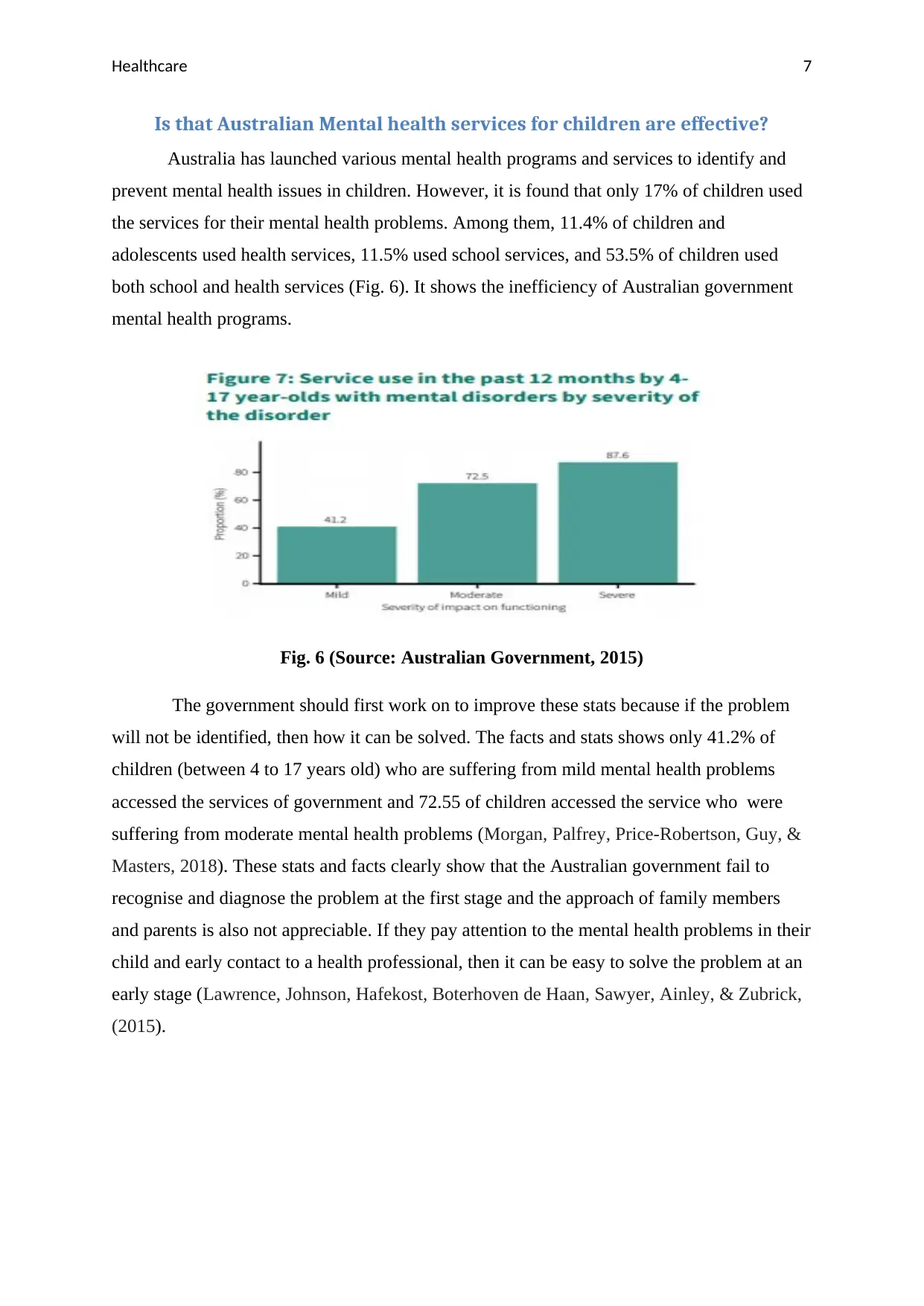
Healthcare 7
Is that Australian Mental health services for children are effective?
Australia has launched various mental health programs and services to identify and
prevent mental health issues in children. However, it is found that only 17% of children used
the services for their mental health problems. Among them, 11.4% of children and
adolescents used health services, 11.5% used school services, and 53.5% of children used
both school and health services (Fig. 6). It shows the inefficiency of Australian government
mental health programs.
Fig. 6 (Source: Australian Government, 2015)
The government should first work on to improve these stats because if the problem
will not be identified, then how it can be solved. The facts and stats shows only 41.2% of
children (between 4 to 17 years old) who are suffering from mild mental health problems
accessed the services of government and 72.55 of children accessed the service who were
suffering from moderate mental health problems (Morgan, Palfrey, Price-Robertson, Guy, &
Masters, 2018). These stats and facts clearly show that the Australian government fail to
recognise and diagnose the problem at the first stage and the approach of family members
and parents is also not appreciable. If they pay attention to the mental health problems in their
child and early contact to a health professional, then it can be easy to solve the problem at an
early stage (Lawrence, Johnson, Hafekost, Boterhoven de Haan, Sawyer, Ainley, & Zubrick,
(2015).
Is that Australian Mental health services for children are effective?
Australia has launched various mental health programs and services to identify and
prevent mental health issues in children. However, it is found that only 17% of children used
the services for their mental health problems. Among them, 11.4% of children and
adolescents used health services, 11.5% used school services, and 53.5% of children used
both school and health services (Fig. 6). It shows the inefficiency of Australian government
mental health programs.
Fig. 6 (Source: Australian Government, 2015)
The government should first work on to improve these stats because if the problem
will not be identified, then how it can be solved. The facts and stats shows only 41.2% of
children (between 4 to 17 years old) who are suffering from mild mental health problems
accessed the services of government and 72.55 of children accessed the service who were
suffering from moderate mental health problems (Morgan, Palfrey, Price-Robertson, Guy, &
Masters, 2018). These stats and facts clearly show that the Australian government fail to
recognise and diagnose the problem at the first stage and the approach of family members
and parents is also not appreciable. If they pay attention to the mental health problems in their
child and early contact to a health professional, then it can be easy to solve the problem at an
early stage (Lawrence, Johnson, Hafekost, Boterhoven de Haan, Sawyer, Ainley, & Zubrick,
(2015).
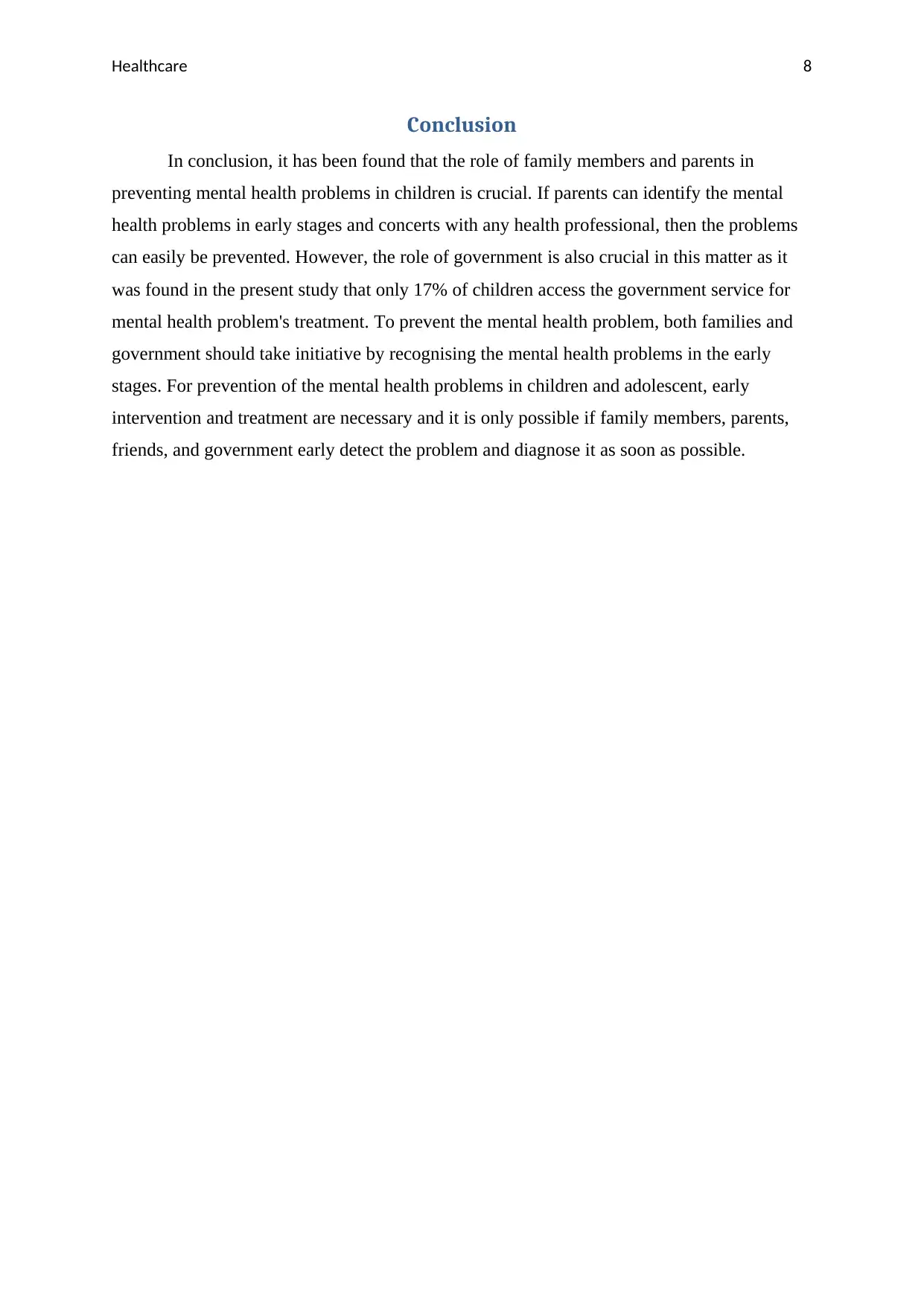
Healthcare 8
Conclusion
In conclusion, it has been found that the role of family members and parents in
preventing mental health problems in children is crucial. If parents can identify the mental
health problems in early stages and concerts with any health professional, then the problems
can easily be prevented. However, the role of government is also crucial in this matter as it
was found in the present study that only 17% of children access the government service for
mental health problem's treatment. To prevent the mental health problem, both families and
government should take initiative by recognising the mental health problems in the early
stages. For prevention of the mental health problems in children and adolescent, early
intervention and treatment are necessary and it is only possible if family members, parents,
friends, and government early detect the problem and diagnose it as soon as possible.
Conclusion
In conclusion, it has been found that the role of family members and parents in
preventing mental health problems in children is crucial. If parents can identify the mental
health problems in early stages and concerts with any health professional, then the problems
can easily be prevented. However, the role of government is also crucial in this matter as it
was found in the present study that only 17% of children access the government service for
mental health problem's treatment. To prevent the mental health problem, both families and
government should take initiative by recognising the mental health problems in the early
stages. For prevention of the mental health problems in children and adolescent, early
intervention and treatment are necessary and it is only possible if family members, parents,
friends, and government early detect the problem and diagnose it as soon as possible.
⊘ This is a preview!⊘
Do you want full access?
Subscribe today to unlock all pages.

Trusted by 1+ million students worldwide
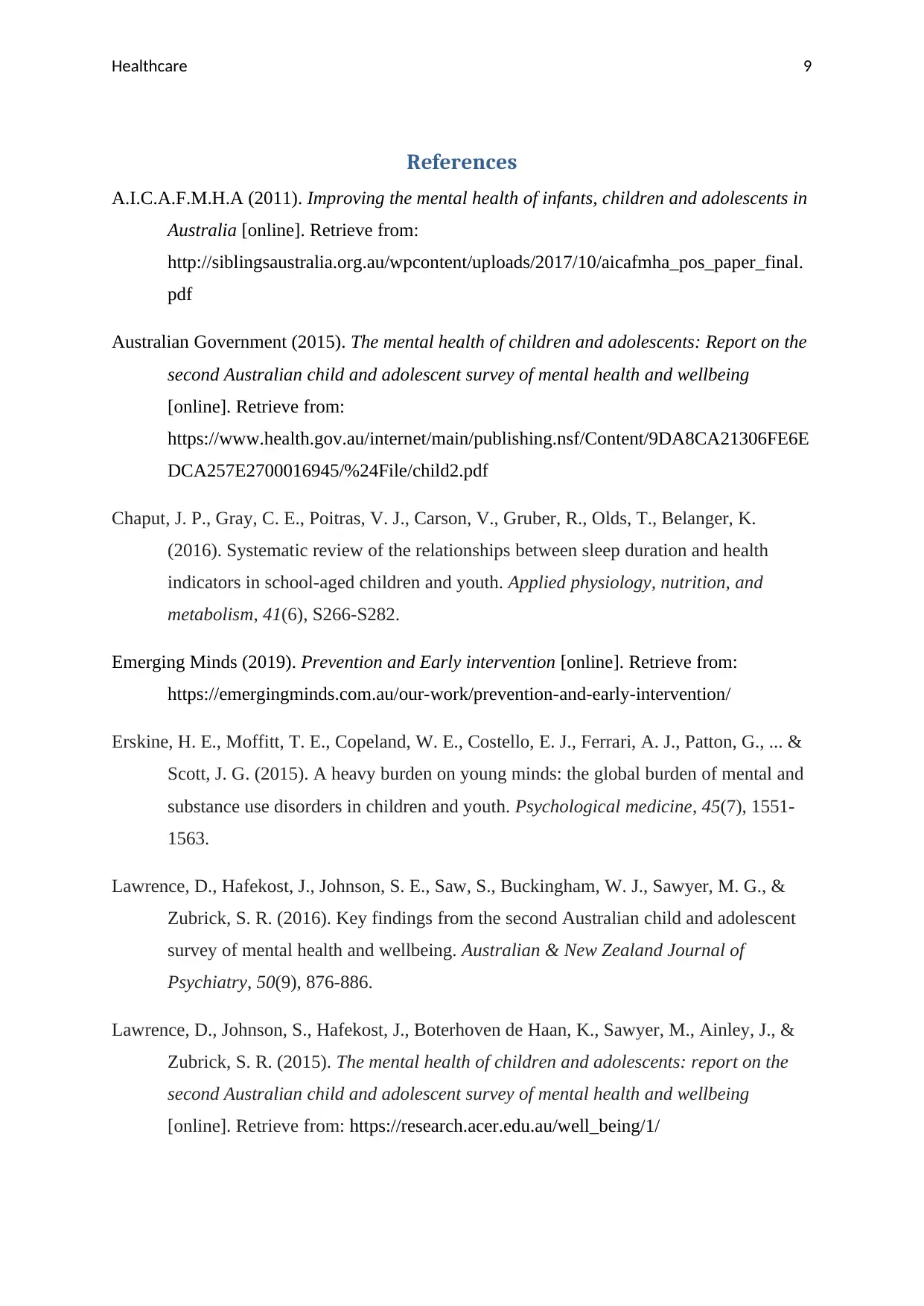
Healthcare 9
References
A.I.C.A.F.M.H.A (2011). Improving the mental health of infants, children and adolescents in
Australia [online]. Retrieve from:
http://siblingsaustralia.org.au/wpcontent/uploads/2017/10/aicafmha_pos_paper_final.
pdf
Australian Government (2015). The mental health of children and adolescents: Report on the
second Australian child and adolescent survey of mental health and wellbeing
[online]. Retrieve from:
https://www.health.gov.au/internet/main/publishing.nsf/Content/9DA8CA21306FE6E
DCA257E2700016945/%24File/child2.pdf
Chaput, J. P., Gray, C. E., Poitras, V. J., Carson, V., Gruber, R., Olds, T., Belanger, K.
(2016). Systematic review of the relationships between sleep duration and health
indicators in school-aged children and youth. Applied physiology, nutrition, and
metabolism, 41(6), S266-S282.
Emerging Minds (2019). Prevention and Early intervention [online]. Retrieve from:
https://emergingminds.com.au/our-work/prevention-and-early-intervention/
Erskine, H. E., Moffitt, T. E., Copeland, W. E., Costello, E. J., Ferrari, A. J., Patton, G., ... &
Scott, J. G. (2015). A heavy burden on young minds: the global burden of mental and
substance use disorders in children and youth. Psychological medicine, 45(7), 1551-
1563.
Lawrence, D., Hafekost, J., Johnson, S. E., Saw, S., Buckingham, W. J., Sawyer, M. G., &
Zubrick, S. R. (2016). Key findings from the second Australian child and adolescent
survey of mental health and wellbeing. Australian & New Zealand Journal of
Psychiatry, 50(9), 876-886.
Lawrence, D., Johnson, S., Hafekost, J., Boterhoven de Haan, K., Sawyer, M., Ainley, J., &
Zubrick, S. R. (2015). The mental health of children and adolescents: report on the
second Australian child and adolescent survey of mental health and wellbeing
[online]. Retrieve from: https://research.acer.edu.au/well_being/1/
References
A.I.C.A.F.M.H.A (2011). Improving the mental health of infants, children and adolescents in
Australia [online]. Retrieve from:
http://siblingsaustralia.org.au/wpcontent/uploads/2017/10/aicafmha_pos_paper_final.
Australian Government (2015). The mental health of children and adolescents: Report on the
second Australian child and adolescent survey of mental health and wellbeing
[online]. Retrieve from:
https://www.health.gov.au/internet/main/publishing.nsf/Content/9DA8CA21306FE6E
DCA257E2700016945/%24File/child2.pdf
Chaput, J. P., Gray, C. E., Poitras, V. J., Carson, V., Gruber, R., Olds, T., Belanger, K.
(2016). Systematic review of the relationships between sleep duration and health
indicators in school-aged children and youth. Applied physiology, nutrition, and
metabolism, 41(6), S266-S282.
Emerging Minds (2019). Prevention and Early intervention [online]. Retrieve from:
https://emergingminds.com.au/our-work/prevention-and-early-intervention/
Erskine, H. E., Moffitt, T. E., Copeland, W. E., Costello, E. J., Ferrari, A. J., Patton, G., ... &
Scott, J. G. (2015). A heavy burden on young minds: the global burden of mental and
substance use disorders in children and youth. Psychological medicine, 45(7), 1551-
1563.
Lawrence, D., Hafekost, J., Johnson, S. E., Saw, S., Buckingham, W. J., Sawyer, M. G., &
Zubrick, S. R. (2016). Key findings from the second Australian child and adolescent
survey of mental health and wellbeing. Australian & New Zealand Journal of
Psychiatry, 50(9), 876-886.
Lawrence, D., Johnson, S., Hafekost, J., Boterhoven de Haan, K., Sawyer, M., Ainley, J., &
Zubrick, S. R. (2015). The mental health of children and adolescents: report on the
second Australian child and adolescent survey of mental health and wellbeing
[online]. Retrieve from: https://research.acer.edu.au/well_being/1/
Paraphrase This Document
Need a fresh take? Get an instant paraphrase of this document with our AI Paraphraser
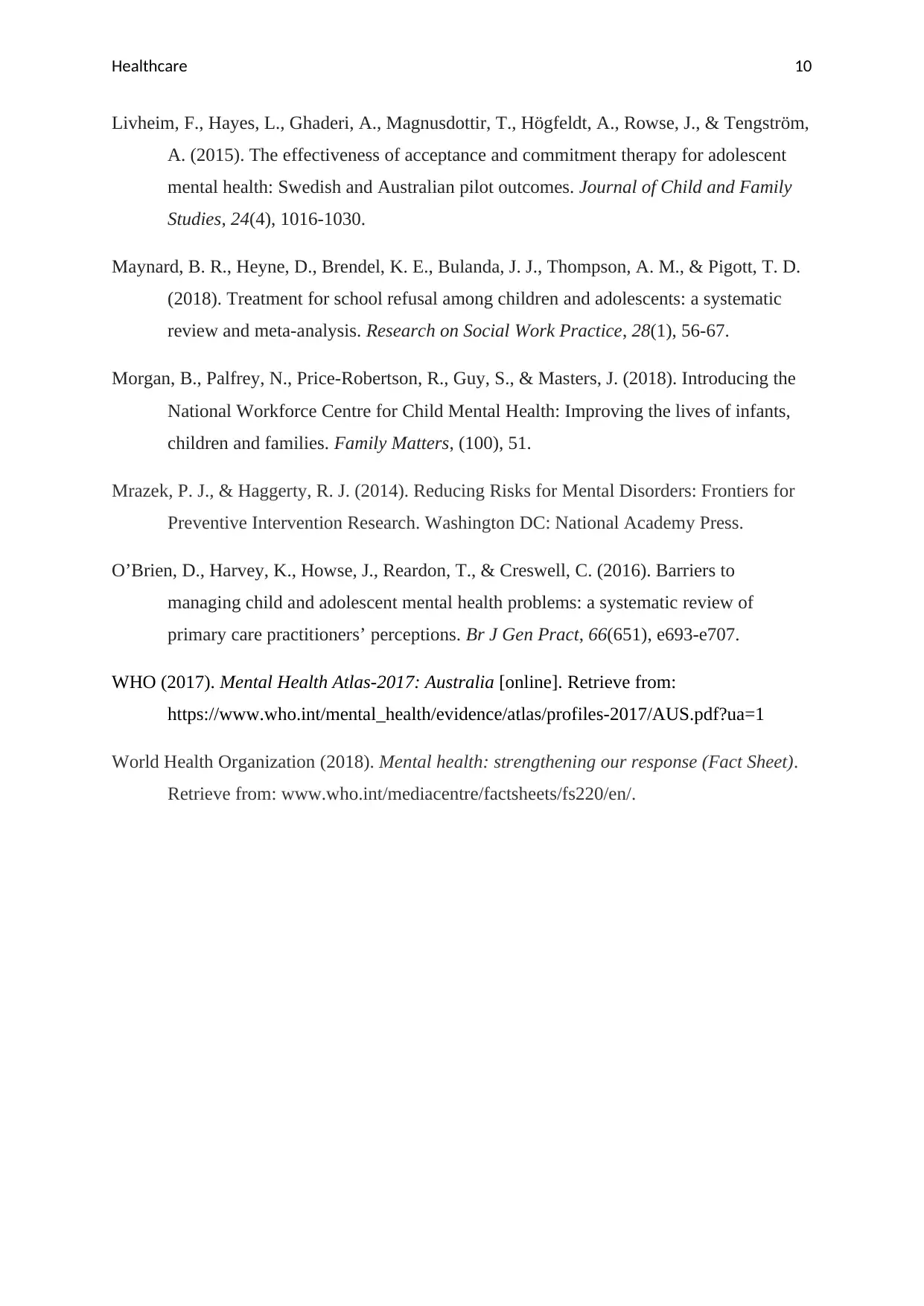
Healthcare 10
Livheim, F., Hayes, L., Ghaderi, A., Magnusdottir, T., Högfeldt, A., Rowse, J., & Tengström,
A. (2015). The effectiveness of acceptance and commitment therapy for adolescent
mental health: Swedish and Australian pilot outcomes. Journal of Child and Family
Studies, 24(4), 1016-1030.
Maynard, B. R., Heyne, D., Brendel, K. E., Bulanda, J. J., Thompson, A. M., & Pigott, T. D.
(2018). Treatment for school refusal among children and adolescents: a systematic
review and meta-analysis. Research on Social Work Practice, 28(1), 56-67.
Morgan, B., Palfrey, N., Price-Robertson, R., Guy, S., & Masters, J. (2018). Introducing the
National Workforce Centre for Child Mental Health: Improving the lives of infants,
children and families. Family Matters, (100), 51.
Mrazek, P. J., & Haggerty, R. J. (2014). Reducing Risks for Mental Disorders: Frontiers for
Preventive Intervention Research. Washington DC: National Academy Press.
O’Brien, D., Harvey, K., Howse, J., Reardon, T., & Creswell, C. (2016). Barriers to
managing child and adolescent mental health problems: a systematic review of
primary care practitioners’ perceptions. Br J Gen Pract, 66(651), e693-e707.
WHO (2017). Mental Health Atlas-2017: Australia [online]. Retrieve from:
https://www.who.int/mental_health/evidence/atlas/profiles-2017/AUS.pdf?ua=1
World Health Organization (2018). Mental health: strengthening our response (Fact Sheet).
Retrieve from: www.who.int/mediacentre/factsheets/fs220/en/.
Livheim, F., Hayes, L., Ghaderi, A., Magnusdottir, T., Högfeldt, A., Rowse, J., & Tengström,
A. (2015). The effectiveness of acceptance and commitment therapy for adolescent
mental health: Swedish and Australian pilot outcomes. Journal of Child and Family
Studies, 24(4), 1016-1030.
Maynard, B. R., Heyne, D., Brendel, K. E., Bulanda, J. J., Thompson, A. M., & Pigott, T. D.
(2018). Treatment for school refusal among children and adolescents: a systematic
review and meta-analysis. Research on Social Work Practice, 28(1), 56-67.
Morgan, B., Palfrey, N., Price-Robertson, R., Guy, S., & Masters, J. (2018). Introducing the
National Workforce Centre for Child Mental Health: Improving the lives of infants,
children and families. Family Matters, (100), 51.
Mrazek, P. J., & Haggerty, R. J. (2014). Reducing Risks for Mental Disorders: Frontiers for
Preventive Intervention Research. Washington DC: National Academy Press.
O’Brien, D., Harvey, K., Howse, J., Reardon, T., & Creswell, C. (2016). Barriers to
managing child and adolescent mental health problems: a systematic review of
primary care practitioners’ perceptions. Br J Gen Pract, 66(651), e693-e707.
WHO (2017). Mental Health Atlas-2017: Australia [online]. Retrieve from:
https://www.who.int/mental_health/evidence/atlas/profiles-2017/AUS.pdf?ua=1
World Health Organization (2018). Mental health: strengthening our response (Fact Sheet).
Retrieve from: www.who.int/mediacentre/factsheets/fs220/en/.
1 out of 11
Related Documents
Your All-in-One AI-Powered Toolkit for Academic Success.
+13062052269
info@desklib.com
Available 24*7 on WhatsApp / Email
![[object Object]](/_next/static/media/star-bottom.7253800d.svg)
Unlock your academic potential
Copyright © 2020–2025 A2Z Services. All Rights Reserved. Developed and managed by ZUCOL.





